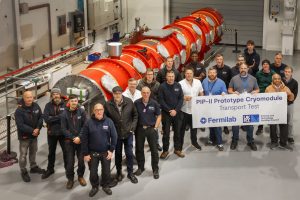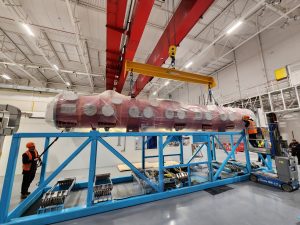A highly technical and delicate piece of equipment weighing 27,500 pounds, or 12,500 kilograms, just made a whirlwind transatlantic trip in its custom transportation frame.
The fully equipped prototype of a cryomodule is one of the many components that will be part of the new linear particle accelerator at the U.S. Department of Energy’s Fermi National Accelerator Laboratory. The successful shipment was an important transportation test and part of Fermilab’s Proton Improvement Plan II project, PIP-II, which receives contributions from several international partners, including the United Kingdom.
The PIP-II project team is constructing a 215-meter-long, state-of-the-art superconducting particle accelerator to upgrade Fermilab’s accelerator complex. At 10 meters long, the HB650 is the largest cryomodule needed for the new accelerator. Four modules will make up the last section of the new machine. When complete, the PIP-II accelerator will produce the world’s most powerful neutrino beam for the international Deep Underground Neutrino Experiment, hosted by Fermilab.

Members of the PIP-II team from Fermilab and STFC UKRI stand in front of the prototype HB650 cryomodule at Daresbury Laboratory. Credit: STFC
Neutrinos are the most abundant matter particles in the universe. By sending neutrinos from Fermilab, close to Chicago, to the huge detectors of DUNE in Lead, South Dakota, physicists can study the particles’ mysterious behavior and search for answers to the universe’s biggest questions.
PIP-II will receive components from partner institutions in France, India, Italy, Poland and the United Kingdom. Fermilab will receive three assembled cryomodules — known as HB650 for the radio frequency they use to operate — from their partners at the Science and Technology Facilities Council in the U.K. and ten similar ones from partners at Commissariat à l’Énergie Atomique et aux Énergies Alternatives, or CEA, in France.
To ensure that all three cryomodules make it safely from STFC’s Daresbury Laboratory near Liverpool to Fermilab, the PIP-II team is conducting extensive tests of the transportation system. Shipping the prototype cryomodule from Fermilab to the U.K. and back was the final test before shipping the first actual cryomodule built in the U.K. to the United States.
In 2022, the collaboration assembled a special transportation frame, designed to fit the HB650 cryomodule, at Fermilab. STFC led the frame’s development with assistance from PIP-II collaborators at Fermilab and CEA in France.

The prototype HB650 cryomodule, wrapped in plastic, is lowered into its custom transport frame after being inspected at Daresbury Laboratory. Credit: Jeremiah Holzbauer, Fermilab
The PIP-II team then performed a successful transportation test with the frame and concrete blocks with the dimensions, weight and mounting points of the actual cryomodule.
PIP-II staff completed the prototype HB650 cryomodule at Fermilab in early 2023. It includes three superconducting radio-frequency cavities for particle acceleration made by partners at the Raja Ramanna Centre for Advanced Technology, provided as in-kind contributions from India.
The first of its kind in the world, the cryomodule underwent months of testing before the PIP-II team loaded it into the transportation frame for its trip to the U.K. and back. It departed Fermilab on Nov. 27. The cryomodule flew on a cargo plane to Luxembourg and then rode on a truck to Daresbury Laboratory, where it was tested. It returned to Fermilab along the same route and arrived on Dec. 14.

The PIP-II team tracked the prototype cryomodule with a GPS device as it traveled from Fermilab to Daresbury Laboratory in the United Kingdom. This map shows the European leg of its journey. Credit: Adam Wixson, Fermilab
The successful completion of this test is the final demonstration that the many challenging aspects of transporting cryomodules are well understood. This includes logistics, customs, handling, instrumentation and, especially, the detailed design of the many delicate components in the cryomodule.
“Our partners require that we manage the risks of this equipment transportation,” said Jeremiah Holzbauer, PIP-II scientist and former transportation manager. “This successful transport of a real cryomodule to and from a partner institution is the proof that we can execute what the project needs. We encountered and overcame many challenges during our tests. In the end, the prototype cryomodule shipment went basically flawlessly — and that’s because we were well prepared.”
Fermi National Accelerator Laboratory is supported by the Office of Science of the U.S. Department of Energy. The Office of Science is the single largest supporter of basic research in the physical sciences in the United States and is working to address some of the most pressing challenges of our time. For more information, please visit science.energy.gov.



